- Lesson One: The Number One
- ... in Geometry
- ... in Nature
- ... in Culture
- "Uroboros" (related artwork by the author)
- "Creation" (related artwork by the author)
- Lesson Two: The Square Root of Two
- ... in Geometry
- ... in Nature, Part 1
- ... in Nature, Part 2
- ... in Culture, Part 1
- ... in Culture, Part 2
- "Duality" (related artwork by the author)
- Lesson Three: The Square Root of Three
- ... in Geometry
- ... in Nature
- ... in Culture
- "Vesica" (related artwork by the author)
- Lesson Four: Phi, or the Golden Proportion
- ... Intro, Part 2
- ... Intro, Part 3
- ... in Geometry
- ... in Nature
- ... in Nature, Part 2
- ... in Culture
- "The Flower of Phi" (related artwork by the author)
- Lesson Five: The Five Perfect Solids
- ... Intro, Part 2
- ... The Tetrahedron
- ... The Octahedron
- ... The Cube
- ... The Icosahedron
- ... The Dodecahedron
Phi in Plant Forms:
When one looks into the absolutely vast amount of information that has been collected on the extensive number of forms in which Nature employs the proportion of Phi, it is obvious that there is no other specific number that recurs throughout life on Earth with such regularity. If we were to attempt to deal with all of the instances of Phi in Nature, we would be forced to dedicate an entire website, if not several, to the subject. In fact, there are many books and websites that focus solely on the subject of the Golden Ratio in Nature. Because of the fact that many other authors have already dealt with this subject in exhaustive studies, Nature's Word will only deal with "the tip of the iceburg" - it is suggested that the interested reader look to other sources for more information after reading that which is presented here.
To begin with, let's start with Phi as it is found in the realm of plant life. If the central stem of a plant is looked at closely, it can be seen that as the plant grows upward, leaves or branches sprout off of the stem in a spiraling pattern. In other words, in an over-simplified example, the plant grows up an inch, and a leaf or branch sprouts out of the stem. Then the plant grows up another inch, and once again a leaf or branch sprouts out, but this time it sprouts out in a different direction than the first. Once again, the plant grows upwards and another leaf or branch grows out of the stem, and once again we find that the leaf or branch has sprouted in a different direction than the one before it. If we were to connect the tips of the leaves or branches that have grown out of the stem, we would find that they create a very definite spiral pattern around the central stem.
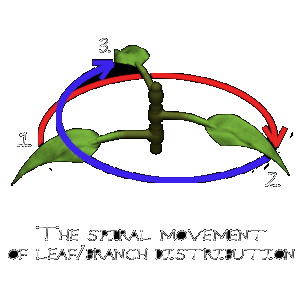 Original artwork created by A. O'Connor for Nature's Word using POV-Ray and Adobe Photoshop 5.0.
Original artwork created by A. O'Connor for Nature's Word using POV-Ray and Adobe Photoshop 5.0.In an overwhelming number of plants, a given branch or leaf will grow out of the stem approximately 137.5 degrees around the stem relative to the prior branch. In other words, after a branch grows out of the plant, the plant grows up some amount and then sends out another branch rotated 137.5 degrees relative to the direction that the first branch grew out of.
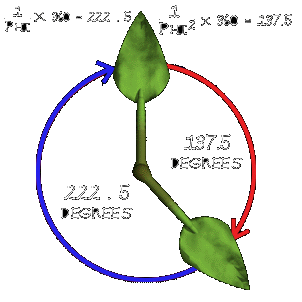 Original artwork created by A. O'Connor for Nature's Word using POV-Ray and Adobe Photoshop 5.0.
Original artwork created by A. O'Connor for Nature's Word using POV-Ray and Adobe Photoshop 5.0.All plants use a constant amount of rotation in this way, although not all plants use 137.5 degrees. However, it is believed that the majority of all plants make use of either the 137.5 degree rotation or a rotation very close to it as the core number in their leaf or branch dispersion, sending out each and every leaf or branch after rotating 137.5 degrees around the stem relative to the prior branch.
If we were to multiply the value of 1 over Phi to the second power (0.3819659...) times the total number of degrees in a circle (360), we obtain for a product nothing other than 137.50... degrees. As an alternate way to look at the same idea, if we were to take the value of 1 over Phi (0.6180339) and multiply it by 360, we obtain approximately 222.5 degrees. If we then subtract 222.5 from 360 we again find 137.5 degrees - in other words, the complimentary angle to 1 over Phi is 137.5 degrees, which also happens to be the value of 1 over Phi to the second power times 360.
So, if we have followed the described mathematics, it is clear that any plant that employs a 137.5 degree rotation in the dispersion of its leaves or branches is using a Phi value intrinsically in its very form. Considering our discussion in the prior section on Phi in geometry, it is interesting to note the off-balance five-pointed star that can be seen in the leaf pattern of plants that employ a 137.5 rotation scheme when they are viewed from above.
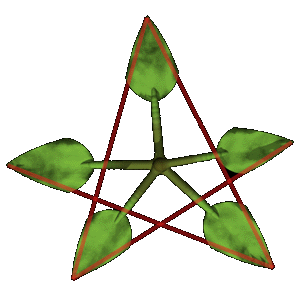 Original artwork created by A. O'Connor for Nature's Word using POV-Ray and Adobe Photoshop 5.0.
Original artwork created by A. O'Connor for Nature's Word using POV-Ray and Adobe Photoshop 5.0.Two images have been provided here - one with five leaves, and the other with ten, so that the lopsided five-pointed design can be more easily understood. The red lines in both images connect the tips of the leaves in the order that they grow up the stem.
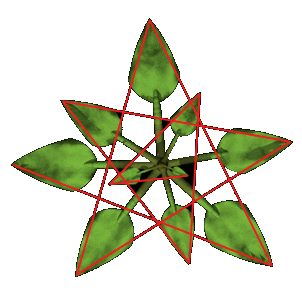 Original artwork created by A. O'Connor for Nature's Word using POV-Ray and Adobe Photoshop 5.0.
Original artwork created by A. O'Connor for Nature's Word using POV-Ray and Adobe Photoshop 5.0.It can definitely be said that there is a perfectly good "scientific" reason why plants would happen to utilize a 137.5 rotation in the spiraling growth of their leaves. Simply put, this exact amount of rotation causes the least amount of overlap of any given leaf by those leaves located higher on the stem. If the ten-leaf image is viewed at left, it can be seen that every leaf is completely exposed when viewed from the top. Far from being merely aesthetic, this means that each leaf receives the maximum amount of sunlight to assist in photosynthesis, the process by which plants turn carbon dioxide into energy for growth and sustenance. In addition, the Phi rotation contributes greatly to the overall balance of the plant, no matter what size it grows to become.
Now we begin to see that Phi is not only a highly philosophical number, but in fact leads to maximal efficiency in certain lifeforms as well. If the rate of rotation were even slightly varied from 137.5 degrees, the minor discrepancy added up with every passing leaf rotation would lead overall to a formidable loss of efficiency. The rate of rotation governed by Phi is, once again, the only number that can produce such perfected efficiency, and it remains so regardless of the eventual size and scale that the plant attains.
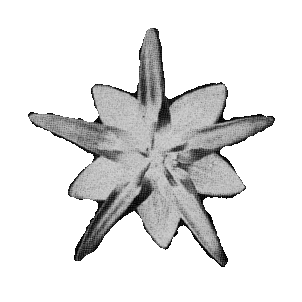 Taken From: Robert Lawlor's book Sacred Geometry; Philosophy and Practice, Thames and Hudson, 1982
Taken From: Robert Lawlor's book Sacred Geometry; Philosophy and Practice, Thames and Hudson, 1982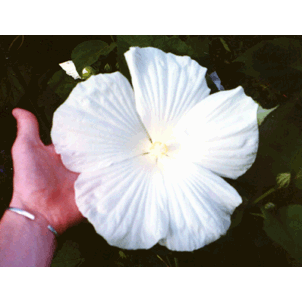 Taken From: Robert Lawlor's book Sacred Geometry; Philosophy and Practice, Thames and Hudson, 1982
Taken From: Robert Lawlor's book Sacred Geometry; Philosophy and Practice, Thames and Hudson, 1982 Original photograph taken by A. O'Connor for Nature's Word
Original photograph taken by A. O'Connor for Nature's WordIf we continue up the stem or out a branch of many plants we find at their termination that part of the plant in charge of passing on the seed, known as the flower. Flowers often consist of a seed pod or seed base surrounded by petals. It is no coincidence that if we were to count the number of petals on any given plant, chances are better than average that the number of petals will be a number from the Fibonacci series - which we already learned intrinsically expresses the Phi ratio. The following table lists a few of the plants that have Fibonacci numbers in the petals of their flowers.
| Numberof Petals | Type of Flower |
| 2 | Enchanter's Nightshade |
| 3 | Iris, Lilies, Trillium |
| 5 | All edible fruits, Delphiniums, Larkspurs, Buttercups, Columbines, Milkwort |
| 8 | Other Delphiniums, Lesser Celandine, some Daisies, Field Senecio |
| 13 | Globe Glower, Ragwort, "Souble" Selphiniums, Mayweed, Corn Marigold, Chamomile |
| 21 | Heleniums, Asters, Chicory, Doronicum, some Hawkbits, many wildflowers |
| 34 | Common Daisies, Plantains, Gaillardias, |
| 55 | Michaelmas Daisies |
| 89 | Michaelmas Daisies |
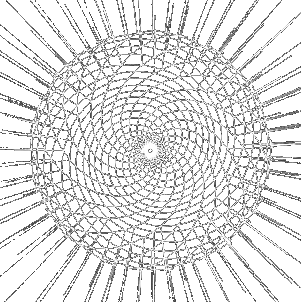 Taken From: Robert Lawlor's book Sacred Geometry; Philosophy and Practice, Thames and Hudson, 1982
Taken From: Robert Lawlor's book Sacred Geometry; Philosophy and Practice, Thames and Hudson, 1982The grouping of seeds in a plant's seed pod or seed base is often directly governed by Phi as well. Perhaps the most beautiful (and well known) example of the use of Phi in seed organization is in the majestic plant known as the sunflower. In the seed base located in the center of the sunflower's large flower, the seeds are laid out according to a very specific geometric pattern. If it is closely observed, one can see that there is a pattern involving two sets of spirals that criss-cross, with one set of spirals turning clockwise, and the other turning counter-clockwise. At each location where two spirals cross a seed can be found. The number of spirals turning counter-clockwise happens to be 55, and the number of clockwise spirals happens to be 89 - both Fibonacci numbers. If the rotational rates of these two sets of spirals are analyzed, it will be discovered that they are also ruled by the Golden Spiral discussed in the last section.
Pine trees are also heavily influenced by Fibonnaci numbers and the Phi proportion. The needles that grow from pine tree branches do so in small groups. If the number of needles is counted in a given group, the answer will most certainly be a Fibonacci number, with different species of pine making use of different Fibonacci numbers - most often 3, 5, or 8 needles per group.
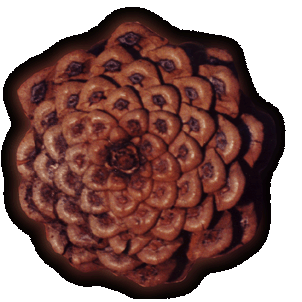
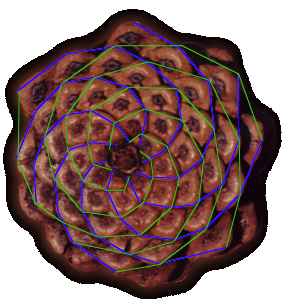
In addition, the surface pattern of the pinecone is determined by the Phi ratio, once again being generated by two counter-rotating sets of spirals much as we saw with the sunflower. In pinecones we find either five and eight spirals turning against one another, or eight and thirteen, depending on the species of the pine tree that bore it. Do not fail to note that the pinecone serves the same function and the sunflower's flower does - that of seed-bearer.
 Taken From: Robert Lawlor's book Sacred Geometry; Philosophy and Practice, Thames and Hudson, 1982
Taken From: Robert Lawlor's book Sacred Geometry; Philosophy and Practice, Thames and Hudson, 1982The same counter-spiraling Golden Spiral pattern can be observed in the seed distribution of many cacti. This example shows the pattern particularly clearly.
Perhaps the easiest way for the reader to do a bit of sacred geometry research on their own is to venture into their own refrigerator and cut up some common vegetables and fruits. The tiny seeds that lace the outside of a strawberry are laid out in a pattern determined in the same way that sunflower seeds, pine cones, and cacti are. A pineapple's outer surface is ruled by the same pattern. Cutting an apple in half horizontally (from side to side, not top to bottom) reveals an excellent five-pointed star distribution of seeds. The tiny florets of cauliflower and broccoli are grouped by fives, the groupings of which themselves are grouped into larger groups of fives in an astonishing fractal-style pattern. If a head of cabbage is cut in half sideways, the Phi rotation described above in association with branches and leaves can be clearly seen in the dense white parts of the vegetable.
The list literally goes on and on. The reader is encouraged to look around him or herself and find Phi leaf cycles, Golden Spirals, and Fibonacci groupings in the plants of their own environment. There is no lack of examples to be found - in fact, it is safe to say that one could look for the rest of their life and there would still be more examples of Phi's use in plant life to be found.


